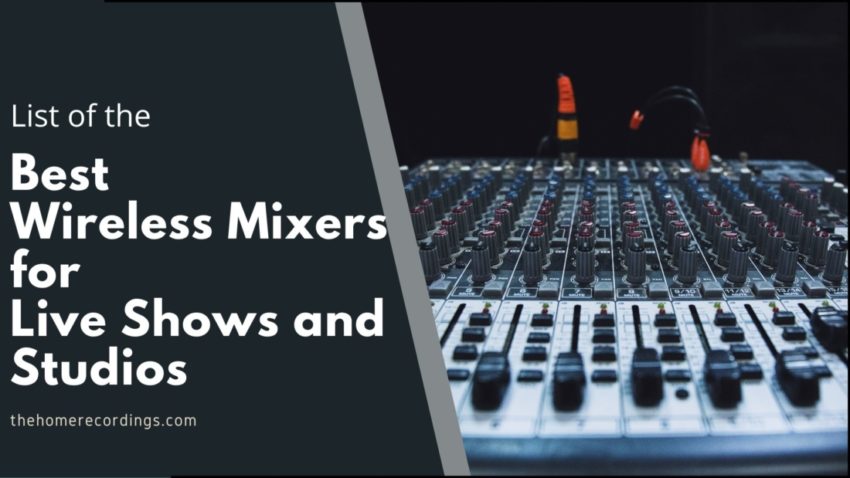Last updated on December 31st, 2023 at 05:53 pm
Tablet controlled-, or wireless mixers have become very popular over the last years.
Being able to leave the mixer on stage near the musicians without the need of running long cables all over the venue is something that can make your life a lot easier as an engineer.
Wireless mixers not only allow the engineer to mix from anywhere in the room, but also give the musicians the opportunity to control their own monitor/headphone mixes directly from a tablet or their phone while playing on stage.
I’ve put together a list of the best wireless mixers available today simply to make it easier for people to find the best one that suits their needs.
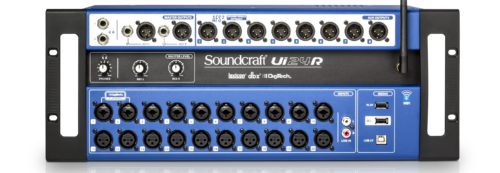
Soundcraft UI24R
Multitrack recording capabilities, built-in amp modeling, connect 10 devices for controlling headphone mix, effects, etc.
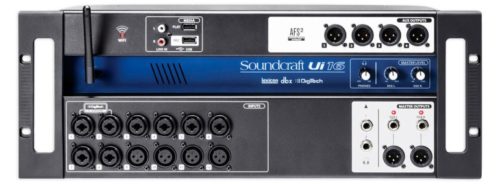
Soundcraft UI12
12-channel mixer (can’t record multitrack) designed for live use. Includes great-sounding amp modeling software.
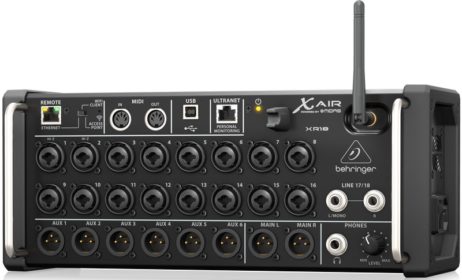
Behringer X-Air XR18
18-channel multitrack mixer, includes UltraNet port for controlling different mixes on stage, and multiple effects.
Let’s get started…
Wireless Digital Mixers
Important note: None of the mixers listed in this first section are capable of doing multitrack recording onto a PC/Mac.
However, I will be listing a couple of ones that actually do provide multitrack recording capabilities after I finish with these ones.
Soundcraft ui12 and 16
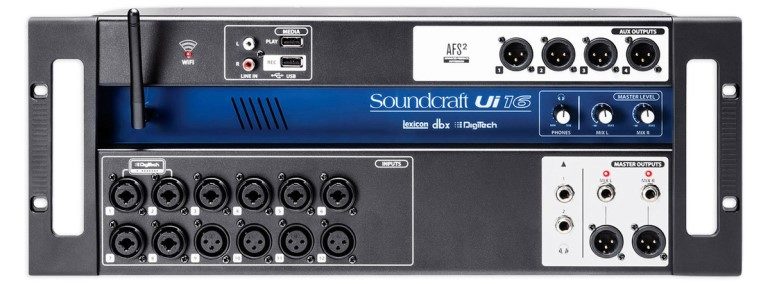
These are two almost identical wireless mixers with the only difference lies in the channel count they each provide, which are 12 and 16, respectively.
The Inputs of the Soundcraft UI12 are: 4 x XLR/TRS combo jacks, 4 x XLR, and a stereo RCA…
While the outputs of the UI12 are: 2 x XLR and 2 x TRS connectors for the main outputs, and 2 extra XLR aux outputs, as well as 2 x ¼” headphone outputs.
The inputs of the Soundcraft UI16 are: 8 x XLR/TRS Combo jacks, 4 x XLR, and a stereo RCA.
While the outputs are: 2 x XLR and 2 x TRS connectors for the main outputs, and 4 extra XLR aux outputs, as well as 2 x ¼” headphone outputs.
On both mixers, the first two inputs are also Hi-Z inputs which feature DigiTech’s amp modeling.
These inputs are designed to connect an electric guitar/bass directly to the mixer without the need of using a D.I. box.
This can definitely come in handy during live gigs where you don’t want to take guitar amps along, since these amp sims actually sound quite convincing.
The great thing about the Soundcraft wireless mixers is that you can connect to them through Wi-Fi and control their internal software via any HTML5-compatible browser…
And basically, every device out there can run such a browser (Chrome, Firefox, Safari, etc).
The software, which is used to control everything that’s going on inside the mixer, feels very similar to a regular DAW…
It’s super intuitive.
Here’s how it looks;
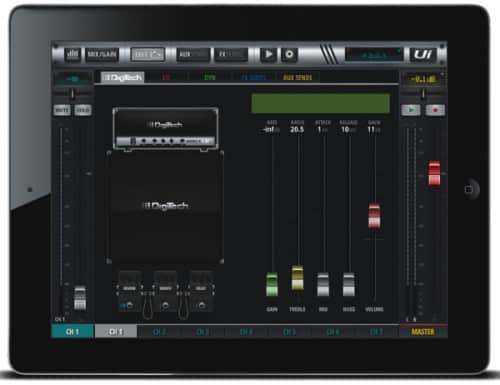
Note: It also has an Ethernet port, should you want to connect to the mixer via it.
Most wireless mixers require you to download an app, but with the Soundcraft mixers you just connect to the Wi-Fi they provide, and that’s it!
Not only that, but you can connect up to 10 different devices, which means that every band member can control their own effects, monitor mix, amp sim, etc.
There is even an HDMI output and an extra USB port so that you can hook up a monitor and mouse if you want to.
Moving on…
Onboard Effects
These mixers come with the Lexicon effects which include; reverbs, delay, and chorus.
Each channel also has Compression, de-essing, and noise-gating built-in, plus a real-time frequency analyzer.
As I mentioned earlier, amp emulation for the first two inputs is also included, which provides a huge array of amps, cabinets, pedal effects, and more.
Feedback Fighting
The Soundcraft wireless mixers come with an advanced feedback suppression algorithm that listens to the incoming signal and can anticipate the problematic frequencies before the feedback begins.
This feedback suppression system won’t affect the sound of the performance one bit!
Recording capabilities
While it would be great to be able to do some multi-track recording with these mixers, it sadly can’t be done.
You can, however, record the entire session onto a pen drive as a stereo file and then transfer this file to your PC/DAW.
And lastly…
These mixers will allow you to connect an external USB drive and play back music from it.
Features
- Can be controlled via any device that can open a browser
- Built-in effects and amp sims
- Integrated Wi-Fi connects up to 10 devices simultaneously
- 2-channel feedback suppressor
- Solid construction and design
Specifications
| Model | Soundcraft UI12 | Soundcraft UI16 |
| Channels | 12 | 16 |
| Inputs | 4 x XLR/TRS, 4 x XLR, 1 x RCA | 8 x XLR/TRS, 4 x XLR, 1x RCA |
| Outputs | 2 x XLR, 2 x TRS, 2 XLR AUX | 2 x XLR, 2 x TRS, 4 XLR AUX |
| MIDI I/O | No | No |
| Headphone Output | 2 x ¼” | 2 x ¼” |
| EQ Bands | 4-band Parametric | 4-band Parametric |
| Rackmountable | No | Yes |
| Multi-track Recording | No | No |
| USB Rec/Playback | Yes | Yes |
| App Required | No | No |
| Feedback Control | Yes | Yes |
Both Mixers are very affordable considering the number of inputs/outputs they provide, as well as the included effects, amp sims, and all other features.
They are definitely very cost-effective, which is always nice.
Find out more about the Soundcraft UI12 and the UI16 models here:
- Soundcraft UI12: Amazon, Sweetwater.
- Soundcraft UI16: Amazon, Sweetwater.
Read also: Best Home Studio Mixers; Analog & Digital.
Peavey Unity DR16 Digital Rack Mixer
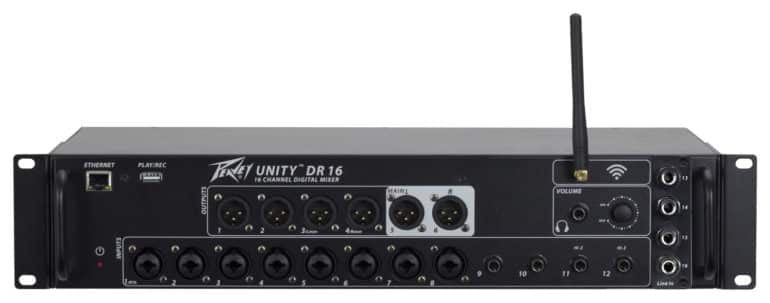
The Peavey Unity DR16 is fairly similar to the Soundcraft wireless mixers.
This is a 16-channel mixer that provides you with 8 x XLR/¼” combo jack inputs, as well as 4 x ¼” line inputs, and 2 x Hi-Z inputs, for channels 11 and 12, which allow you to directly connect an electric guitar/bass to it.
As far as the outputs go, it provides 2 x XLR Main outputs, 2 x XLR Monitor outputs, a 1 x ¼” headphone output, as well as 2 x XLR AUX Sends.
The Peavey DR16 does need the “Peavey Remote Control APP” to be controlled via Wi-Fi or ethernet, which is pretty standard for most of these mixers today.
Not only that, but it supplies you with up to 10 Ethernet and 4 Wi-Fi connections simultaneously.
This will allow you to tweak the sound directly from the stage, control the effects, monitor and headphone mixes, etc.
However, this is something the Soundcraft mixers actually do better, since you just need a browser to control them, and that’s it!
Here’s a video on how the app works;
Moving on…
Onboard Effects
As far as the onboard effects go, sadly there are no amp sims included.
But it provides some of the common effects: Reverb, Delay, Chorus, Flanger, and Phaser.
As far as EQ goes, you get a Mid-Morph EQ, Parametric EQ, 31-band Graphic, High/Low Pass Filters.
Mid-Morph EQ is two EQ controls in one; When the knob is cut, it pulls out low-mid frequencies that muddy the sound.
When boosted, it shifts to an upper-mid frequency that brightens the vocal range.
A compressor is also included.
Feedback Fighting
The Peavey Unity DR16 comes with two assignable feedback eliminators which can help you prevent unwanted screeching and squealing by listening to the incoming signal and anticipating the problematic frequencies before the feedback begins.
Recording Capabilities
The Peavey DR16 allows you to record the entire session onto a pen drive as a stereo file and then transfer this file to your PC/DAW.
And lastly…
You can connect an external USB drive and play back music from it.
Features
- 10 Ethernet and 4 Wi-Fi connections simultaneously
- 2-channel feedback suppressor
- Solid construction and design
- Mid-Morph EQ
- 4 effects processors and good reverb algorithms
Specifications
| Model | Peavey Unity DR16 |
| Channels | 12 |
| Inputs | 8 x XLR/TRS, 4 x ¼”, 2 x Hi-Z |
| Outputs | 2 x XLR, 2 x TRS, 2 XLR AUX |
| MIDI I/O | No |
| Headphone Output | 1 x ¼” |
| EQ | 4-band Parametric, Mid-Morph, 31-band EQ |
| Rackmountable | Yes |
| Multi-track Recording | No |
| USB Rec/Playback | Yes |
| App required | Peavey Remote App |
| Feedback Control | Yes |
The Peavey Unity DR16, even though it doesn’t provide the Amp Sims like the Soundcraft Mixers, is still a very cost-effective mixer.
With all those inputs and features, you really can’t go wrong.
Find out more about the Peavey Unity DR16 here.
- Peavey Unity DR16: Amazon, Sweetwater.
Behringer X-Air XR12 and XR16
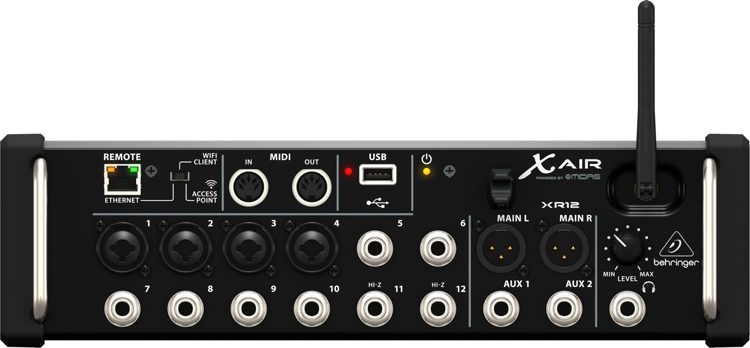
Just like with the Soundcraft mixers I listed in the beginning, the Behringer XR12 and XR16 are two almost identical mixers with the only difference being the overall channel count.
The Behringer XR12 features a total of 12 inputs, four of which are XLR/TRS combo jacks featuring their famous MIDAS preamps.
Of the other eight TRS inputs, 6 are line level, which can be used to connect keyboards, etc.…
While the last two are Hi-Z inputs, which allow you to connect an electric guitar or bass directly without the need of a D.I. box.
As far as the outputs go, the Behringer XR12 provides 2 XLR Main outputs, as well as 2 x ¼” TRS AUX bus out.
On the other hand, the Behringer XR16 features a total of 16 inputs, eight of which are XLR/TRS combo jacks featuring their MIDAS preamps, just like the XR12.
The rest of the inputs are identical to the ones of the XR12.
In regards to the outputs, the Behringer XR16 provides 2 XLR Main outputs, as well as 4 x ¼” TRS AUX bus outputs.
Additionally, both the XR12 and the XR16 also provide MIDI In/Out, which is something the previous mixers didn’t.
Now, just like with most of the mixers on this list, in order to control them, you’re going to need to install the “X-Air App”.
This app can be used on almost any iOS and Android device and if feels almost like a regular DAW.
The only downside to both of these mixers is that you can only connect 4 devices simultaneously through Wi-Fi, which on other mixers is quite higher.
This should still be enough for most gigging bands since every- or almost every member of the band will be able to control their own monitor/headphone mix.
Onboard Effects
Both these mixers come with four built-in true-stereo (8 mono) multi-effects processors, including delay, chorus, and dynamics, as well as a 31-band EQ.
You can also choose any combination of high-end simulations of classic studio reverbs such as the Lexicon 480L and PCM70, the EMT250, or Quantec QRS.
Sadly, there is no included feedback rejection/feedback fighting on these mixers.
Features
- Built-in award-winning MIDAS preamps
- Fully gain-programmable, remote-controllable preamps
- Light and portable
- Good effects processors and reverb algorithms
Specifications
| Model | Behringer XR12 | Behringer XR16 |
| Channels | 12 | 16 |
| Inputs | 4 x XLR/TRS, 6 x ¼” line, 2 x ¼” Hi-Z | 8 x XLR/TRS, 6 x ¼” line, 2 x ¼” Hi-Z |
| Outputs | 2 x XLR, 2 XLR AUX | 2 x XLR, 4 XLR AUX |
| MIDI I/O | Yes | Yes |
| Headphone Output | 1 x ¼” | 1 x ¼” |
| EQ Bands | 100-band Real Time Analyzer | 100-band Real Time Analyzer |
| Rackmountable | Yes | Yes |
| Multi-track Recording | No | No |
| USB Rec/Playback | Yes | Yes |
| App Required | X-Air App | X-Air App |
| Feedback Control | No | No |
Both of these mixers are affordable and will allow you to mix live shows without the need of running cables all over the place.
Find out more about the Behringer XR12 and XR16 here:
- Behringer XR12: Amazon, Sweetwater.
- Behringer XR16: Amazon, Sweetwater.
Related: Here’s a list of the best Home Studio Mixers currently available.
Mackie DL1608 Mixer
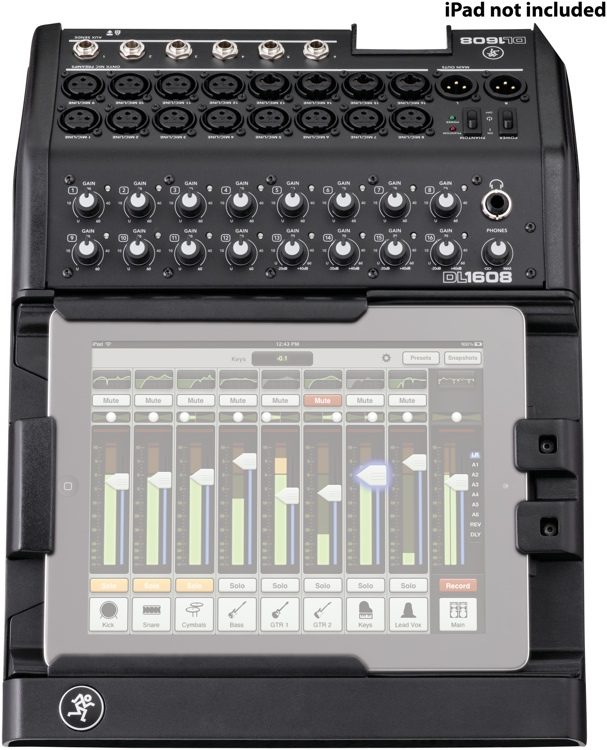
This is a mixer specifically designed to be used with an iPad since you can dock the iPad, allowing you to record directly onto it, or for music playback.
This is also why it’s mostly used for live sound mixing since it can’t be used to record on to a PC/Mac.
However, the “Master Fader Software”, which is used to control the mixer, can be installed on almost any iOS, Android, Mac, and Windows device.
This means that you can still use most of the Mackie DL1608’s features even if you don’t have an iPad…
Just not the recording and music playback features.
Plus, this app is very easy to use and gives you access to all the onboard effects that the Mackie DL1608 has to offer, and it’s consistently being updated.
Here’s a video where you can see exactly how the app works;
The 16 inputs of the Mackie DL1608 are divided into 12 x XLR, and 4 x XLR/TRS combo jacks, each equipped with their great-sounding Onyx preamps.
As far as the outputs go, it comes with 2 x XLR main outputs, 6 x TRS Aux Sends, and 1 x ¼” headphone output.
Note: No MIDI In/Out on this mixer.
The DL1608 even supports up to 10 wireless connections at once, which means that the engineer can mix on one side of the venue, while the musicians on stage can control their own monitor mixes, effects, etc.
Onboard Effects
Each channel features the following effects:
- 4-band PEQ plus a High-Pass Filter
- Compression/Limiting
- RTA/Spectograph
- Reverb
- Delay
Features
- 10 simultaneous wireless connections
- Great control App that’s easy to use
- Durable build
- Allows for iPad docking
Specifications
| Model | Mackie DL1608 |
| Channels | 16 |
| Inputs | 12 x XLR, 4 x XLR/TRS combo |
| Outputs | 2 x XLR main, 6 TRS AUX |
| MIDI I/O | No |
| Headphone Output | 1 x ¼” TRS |
| EQ | 4-band Fully Parametric, 31-band Graphic Master Bus |
| Rackmountable | Yes (via optional kit) |
| Multi-track Recording | No |
| USB Rec/Playback | No (Only through iPad) |
| App required | Master Fader App |
| Feedback Control | No |
Find out more about the Mackie DL1608 here:
- Mackie DL1608: Amazon, Sweetwater.
Zoom LiveTrak L-20R Digital Mixer
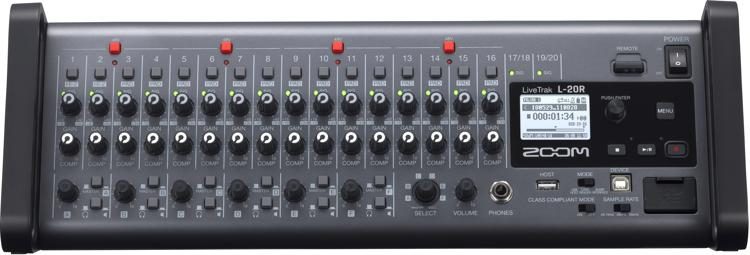
If you read anything about this mixer you might have come to the conclusion that it can do multitrack recording.
While it can record each individual track onto an SD card, the Zoom LiveTrak L-20R only provides a 22-in/4-out USB audio interface for your Mac, PC, or iOS device.
This means that you can only do multitrack recording onto the SD card and then transfer the files over to the PC.
However, it can do both of these things at the same time…
Meaning that you can record a multitrack session onto the SD card while simultaneously streaming over the internet.
Additionally, it allows for “scene saving”…
This is basically when you record the band and later recall those tracks to do a live soundcheck without the band even playing.
Let’s take a quick look at the inputs and outputs provided by the Zoom LiveTrak L20R:
Inputs: It comes with 14 x XLR/TRS Combo Jacks and 2 x XLR/TRS Hi-Z combo Jacks.
The Hi-Z inputs allow you to connect electric and acoustic guitars, as well as bass, without the need of an external D.I. box.
Channels 17/18 and 19/20 have TRS and RCA connectivity for keyboards and other audio devices.
Outputs: It comes with 2 x XLR main outputs as well as 6 XLR customizable monitor outputs, and a ¼” headphone output.
To be able to control this mixer you will need the Remote Mixer app.
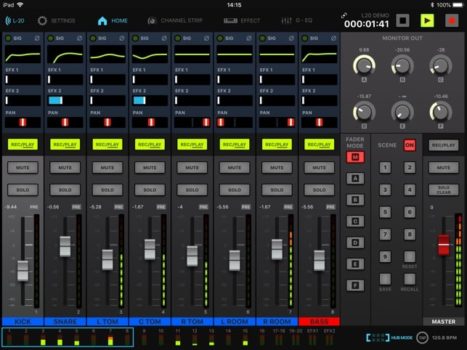
The great thing is that not only can the engineer connect an iPad to it, but it actually allows for up to 6 additional connections simultaneously.
This will let the musicians on stage control their own monitor/in-ear mix and effects.
The Remote Mixer app is intuitive and easy to use, plus it comes with a couple of effects which is nice to have!
Onboard Effects
- Each channel features a 3-band mid-parametric EQ and 20 built-in effects
- Channels 1–16 include a dedicated compressor for controlling dynamics
- Channels 3–16 have a -26dB pad for capturing loud sources
Features
- Create customizable, savable headphone mixes for up to 6 band members
- Save up to 9 scenes and recall your custom settings automatically
- Total of 7 simultaneous connections with the Remote Mixer App
Specifications
| Model | Zoom LiveTrak L-20R |
| Channels | 20 |
| Inputs | 14 x XLR/TRS combo, 2 x XLR/TRS combo Hi-Z, 2 x Dual RCA, 4 x ¼” Stereo line |
| Outputs | 2 x XLR main, 6 XLR AUX (Monitor) |
| MIDI I/O | No |
| Headphone Output | 1 x ¼” TRS |
| EQ | 3-band EQ, Low Cut |
| Rackmountable | Yes |
| Multi-track Recording | Only to SD card |
| USB Rec/Playback | No |
| App required | Remote Mixer app |
| Feedback Control | No |
Find out more about the Zoom LiveTrak L-20R Digital Mixer here:
- Zoom LiveTrak L-20R Digital Mixer: Amazon, Sweetwater.
Wireless Digital Mixers with USB Multi-Track capabilities
These mixers aren’t as affordable as the previous ones for the simple fact that they also work as a multitracking Audio Interface, allowing you to directly record every single track to your PC.
This is why Multitrack mixers are extremely good for home studios, especially if you need a large number of inputs.
Now, all the mixers are controlled via Wi-Fi, which means that they won’t have any physical faders or knobs…
If you only want multitrack mixers that also have regular knobs and faders, then you should check out this post about the best mixers with USB multitrack recording capabilities.
The great thing about wireless mixers is that they can be used for live sound engineering without the need of running cables all over the place…
If you get a wireless mixer with multitrack recording capabilities, then you can actually use it both in the studio, as well as during live performances.
Moving on…
Behringer X Air XR18

The Behringer XR18 is a digital mixer that features a 18-in/18-out USB audio interface.
This basically means that every input can be recorded onto its own track in the DAW.
16 of the inputs are XLR/TRS combo Jacks which feature their famous MIDAS preamps, and an additional 2 x TRS line inputs, as well as MIDI I/O.
The quality of these preamps is actually pretty good, providing you with an excellent signal-to-noise ratio and good headroom.
Both of the first two inputs are also Hi-Z inputs, which allow you to connect an electric guitar without the need of using a D.I. box.
As far as the outputs go, it comes with 2 x XLR Main outputs, the UltraNet port, 6 XLR Aux bus outs, and ¼” TRS headphone output.
The 6 aux outputs can be used to create headphone mixes, or for live monitoring…
While the “Ultranet” port, which connects to the Behringer’s P16 monitor distribution system, allows every musician to create their own headphone mix or their own monitor mix on stage.
The Behringer X-Air XR18 can be controlled via Wi-Fi -with a built-in router- or ethernet, using an Android or iOS device via the X-Air App, which gives you an overview of what’s going on in the mixer.
This app works almost like a DAW and comes included with loads of effects.
It even has an Auto-Mix feature which can manage fully automated mixes with up to 16 live microphones…
This feature is not really intended for mixing live music, but rather conferences.
When it comes to cost-efficiency, the Behringer XR18 is one of the best wireless multitrack mixers out there…
It is super affordable for what you are getting.
Onboard Effects
As far as the effects go, it comes with four built-in true-stereo (8 mono) multi-effects processors, including delay, chorus, and dynamics, as well as a 31-band EQ.
You can also choose any combination of high-end simulations of classic studio reverbs such as the Lexicon 480L and PCM70, the EMT250, or Quantec QRS.
Sadly, there is no included feedback rejection/feedback fighting on these mixers.
Features
- 18-in/18-out USB interface which allows for multitrack recording
- Good onboard effects
- Midas preamps
- Durable and portable build
Specifications
| Model | Behringer XR18 |
| Channels | 18 |
| Inputs | 16 x XLR/TRS, 2 x ¼” line |
| Outputs | 2 x XLR main, ultranet port, 6 XLR AUX |
| MIDI I/O | Yes |
| Headphone Output | 1 x ¼” TRS |
| EQ | 100-band Real Time Analyzer (RTA) |
| Rackmountable | Yes |
| Multi-track Recording | Yes |
| USB Rec/Playback | No |
| App required | X-Air App |
| Feedback Control | No |
Find out more about the Behringer X Air XR18 here:
- Behringer X Air XR18: Amazon, Sweetwater.
Mackie DL16S and DL32S
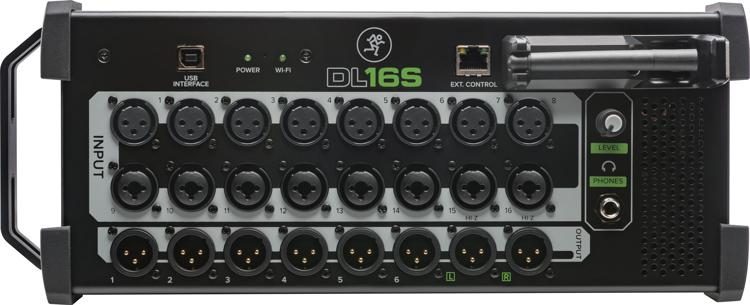
The Mackie DL16S and DL32S are wireless digital mixers that feature a 16-in/16-out and 32-in/32-out audio interfaces respectively.
All of the inputs come with the Onyx+ preamps which are one of the best preamps out there and should provide you with a lot of headroom and a great signal-to-noise ratio.
Speaking of inputs, let’s take a look at them right now, as well as the outputs…
The inputs on the DL16S are: 8 x XLR inputs, 6 x XLR/TRS combo jacks, 2 x XLR/TRS Combo Hi-Z inputs.
The outputs are 2 x XLR Main outputs, 6 x XLR (Assignable) outputs, and a 1 x ¼” TRS headphone output.
The inputs of the DL32S are: 16 x XLR inputs, 14 x XLR/TRS combo jacks, 2 x XLR/TRS Combo Hi-Z inputs.
The outputs are: 2 x XLR Main outputs, 8 x XLR (Assignable) outputs, and a 1 x ¼” TRS headphone output.
Both of these mixers are controlled via Mackie’s “Master Fader App” which can be used on almost any iOS, Android, Mac, or PC device.
What this means is that you can set the mixer up on stage and control it from anywhere you’d like.
The same goes for your home studio since you can set it up in a way where it’s completely out of the way, and then all you need to do is use the app to control it.
This app is fairly easy to use since it’s extremely intuitive, but if you want to see a video of how it works, then either scroll back up the review of the Mackie DL1608, or click on this YouTube link.
Both mixers allow for up to 20 simultaneous Wi-Fi connections, which is way more than any of the mixers I’ve mentioned so far.
The great thing about being able to have so many devices connected simultaneously is that the band members who are playing on stage can actually control their own monitor/headphone mix without needing to bother the engineer.
These mixers also allow you to play back music during intermissions, backing tracks, etc. and they also allow you to play back the full multitrack recording for a virtual soundcheck.
Onboard Effects
Each input comes with a 4-band parametric EQ, highpass filter, noise gate, and compression.
While each output comes with a 4-band parametric EQ, highpass and lowpass filters, 31-band graphic EQ, compressor/limiter, and alignment delay.
Additionally, the mixer provides reverb, delay, and modulation effects.
Sadly, there’s no Feedback Control built into it.
Features
- 16-in/16-out and 32-in/32-out Interfaces which allow for multitrack recording.
- Play intermission music, backing tracks, and more
- Play back your full multitrack recording for a virtual sound check
- Supports up to 20 connected devices through Wi-Fi
Specifications
| Model | Mackie DL16S | Mackie DL32S |
| Channels | 16 | 32 |
| Inputs | 8 x XLR, 6 x XLR/TRS combo, 2 x XLR/¼” Hi-Z | 16 x XLR, 14 x XLR/TRS Combo, 2 x XLR/¼” Hi-Z |
| Outputs | 2 x XLR, 6 XLR Assignable | 2 x XLR, 8 XLR Assignable |
| MIDI I/O | No | No |
| Headphone Output | 1 x ¼” | 1 x ¼” |
| EQ Bands | 4-band Parametric EQ, Highpass Filter | 4-band Parametric EQ, Highpass Filter |
| Rackmountable | Yes | Yes |
| Multi-track Recording | Yes | Yes |
| USB Rec/Playback | Yes, but not to Pen Drive | Yes, but not to Pen Drive |
| App Required | Master Fader App | Master Fader App |
| Feedback Control | No | No |
Find out more about the Mackie DL16S and DL32S here:
- Mackie DL16S: Amazon, Sweetwater.
- Mackie DL32S: Amazon, Sweetwater.
Mackie DL32R

The Mackie DL32R is a wireless digital rack-mounted mixer that comes with the Onyx+ preamps.
Additionally, it features a 32-in/32-out Audio Interface which allows you to record 32 simultaneous tracks onto your DAW.
Not only that, but it’s capable of 32×32 recording onto an external USB hard drive.
It has built-in Wi-Fi so that you can connect it to your PC, iPad, Android Device, etc., and control it using the “Master Fader Control App”, just like all of the Mackie mixers on this list.
Like I already mentioned, this Master Fader App is excellent; It’s super intuitive to use and it basically feels like a regular DAW.
The Mackie DL32R supports up to 20 separate devices connected through Wi-Fi at one.
As far as the inputs and outputs go, the Mackie DL32R provides:
Inputs: 24 x XLR inputs, and 8 x XLR/TRS Combo Jack inputs which feature their great Onyx+ preamps.
Outputs: 14 x XLR Assignable outputs, 2 x TRS Monitor outputs, 1 x AES/EBU (XLR) Digital output, and 1 x ¼” headphone output.
The Mackie DL32R allows for Matrix Mixes which is used to route audio signals from multiple sources to different destinations or zones.
It allows you to create separate mixes from a combination of output signals or buses e.g. aux sends, L/R Main Mix, subgroups, etc.
The purpose of a Matrix is to take what’s already dialed in on your Main LR, Auxes, Subgroups, etc., and combine them as needed for various other uses like;
- Camera Feed
- Creating a 3-Way Crossover
- Running an output to a different zone within your building
- Front Fills
Additionally, the Mackie Dl32R comes with an expansion slot where you can connect the Dante Expansion Card.
The Dante Expansion Card connects the DL32R to any Dante-Enabled audio network, which allows you to route Dante inputs like microphones and other sources to any channel of the DL32R using the Master Fader App.
One fairly reasonable question to ask is “why is the DL32R so much more expensive than the DL32S”?…
Differences between the DL32R and DL32S
| Model | Outputs | Matrix Mixes | Record to Drive | Dante I/O | FX processors |
| DL32S | 10 | No | No | No | 4 |
| DL32R | 16 | 6 | Yes | Yes | 3 (4 with v5.1) |
When purchasing this mixer, it does come with some free software included from Avid, and more.
Onboard Effects
Each input comes with a 4-band parametric EQ, highpass filter, noise gate, and compression.
While each output comes with a 4-band parametric EQ, highpass and lowpass filters, 31-band graphic EQ, compressor/limiter, and alignment delay.
Additionally, the mixer provides reverb, delay, and modulation effects.
Sadly, there’s no Feedback Control built into it.
Features
- 32 Onyx+ preamps
- Extremely well built
- Can use a Dante expansion card
- Allows for Master Mixes
Specifications
| Model | Mackie DL32R |
| Channels | 32 |
| Inputs | 24 x XLR, 8 x XLR/TRS |
| Outputs | 14 x XLR Assignable, 2 x TRS, 1 x AES/EBU (Digital) |
| MIDI I/O | No |
| Headphone Output | 1 x ¼” TRS |
| EQ | 4-band Parametric, 31-band Graphic |
| Rackmountable | Yes |
| Multi-track Recording | Yes |
| USB Rec/Playback | Yes |
| App required | Master Fader App |
| Feedback Control | No |
If you are just building a small home studio, then I honestly believe that the Mackie DL32R is a bit overkill.
You probably will never take advantage of the 32 channels…
However, if you’re looking to expand, or if you need a great mixer for live situations that will allow you to control it from anywhere in the room wirelessly, then it’s definitely a good purchase!
Find out more about the Mackie DL32R here:
- Mackie DL32R: Amazon, Sweetwater.
Soundcraft UI24R

This wireless mixer features a 24-in/24-out audio interface, which means that every single track can be recorded separately onto your DAW.
Let’s take a quick look at the inputs and outputs:
Inputs: It comes with 10 x XLR/1/4″ combo jacks, as well as 10 x XLR jacks all equipped with their Studer-designed preamps.
Not only that but there’s an additional 1 x stereo RCA connection.
Outputs: It comes with 2 x XLR and 2 x 1/4″ main outputs, as well as 8 x XLR (aux outs), and lastly 2 x ¼” headphone outputs.
The first two inputs are also Hi-Z inputs which feature DigiTech’s amp modeling.
These inputs are designed to connect an electric guitar/bass directly to the mixer without the need of using a D.I. box.
This can definitely come in handy during live gigs where you don’t want to take guitar amps along, since these amp sims actually sound quite convincing.
The great thing about the Soundcraft wireless mixers is that you can connect to them through Wi-Fi and control their internal software via any HTML5-compatible browser…
And basically, every device out there can run such a browser (Chrome, Firefox, Safari, etc).
In this image you can see how the software actually looks;

Note: It also has an Ethernet port, should you want to take wired control of this digital mixer via your computer or laptop.
Most wireless mixers require you to download an app, but with the Soundcraft mixers you just connect to the Wi-Fi they provide, and that’s it!
Not only that, but you can connect up to 10 different devices, which means that every band member can control their own effects, monitor mix, amp sim, etc.
There is even an HDMI output and an extra USB port so that you can hook up a monitor and mouse if you want to control it that way.
Moving on…
Onboard Effects
This mixer comes with the Lexicon effects, which include; reverbs, delay, and chorus.
Each channel has also Compression, de-essing, and noise-gating built-in, plus a real-time frequency analyzer.
As I mentioned earlier, amp emulation for the first two inputs is also included, which provides a huge array of amps, cabinets, pedal effects, and more.
Feedback Fighting
The Soundcraft wireless mixers come with an advanced feedback suppression algorithm that listens to the incoming signal and can anticipate the problematic frequencies before the feedback begins.
This feedback suppression system won’t affect the sound of the performance one bit!
Recording capabilities
Not only can you record all of the tracks directly onto your DAW, but you can also connect an external USB drive and play back music from it.
Features
- 22-simultaneous tracks can be recorded
- Can be controlled via any device that can open a browser
- Built-in effects and amp sims
- Integrated Wi-Fi connects up to 10 devices simultaneously
- 2-channel feedback suppressor
- Solid construction and design
Specifications
| Model | Soundcraft UI24R |
| Channels | 24 |
| Inputs | 10 x XLR, 10 x XLR/TRS Combo Jacks, 1 stereo RCA |
| Outputs | 2 x XLR and 2 x ¼” Main, 8 x XLR Aux Outs |
| MIDI I/O | No |
| Headphone Output | 2 x ¼” TRS |
| EQ | 4-band parametric EQ, 31-band graphic EQ |
| Rackmountable | Yes |
| Multi-track Recording | Yes |
| USB Rec/Playback | Yes |
| App required | No, Just browser |
| Feedback Control | Yes |
Find out more about the Soundcraft UI24R here:
- Soundcraft UI24R: Amazon, Sweetwater.
Top Recommendations
Of course, this will all depend both on your budget as well as your needs, since it would make little to no sense to get a mixer that can do multitrack recording if you’re only going to be using it for live shows.
I will give you my top choices both for live- and studio settings;
Best Wireless mixer for live scenarios
Since the Soundcraft mixers are so extremely versatile thanks to the built-in amp simulators and the feedback fighting control, I think that both of them are the winners.
Here are the links to Amazon for both:
As far as the Multitrack mixers go, I’d choose the Mackie DL16S or the Behringer XR18 simply because of their cost-effectiveness.
Here are the links to Amazon for both:
Best all-rounder
By far, I think that the winner here is the Soundcraft UI24R for the simple fact that it provides multitrack recording capabilities, USB Record/Playback functions, Feedback Control, and all those amp sims.
This is why if you want a mixer that is both good for live and studio settings, then the Soundcraft UI24R is your best choice.
Conclusion
Choosing a wireless/tablet-controlled mixer is no easy task since they are so many on the market right now.
I hope this article helped you at least clarify things a little.
All of the mixers on this list are excellent, however, the ones I like the most are the Soundcraft mixers…
Especially the Soundcraft UI24R.
If you have the budget for it and you find all of the features useful, then absolutely go for it!
I hope this information was useful…
Have a wonderful day!
